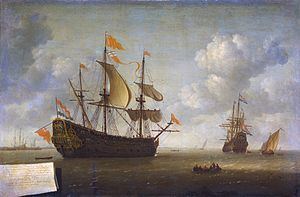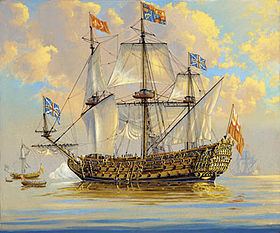Name Naseby Launched 12 April 1655 | Ordered 3 July 1654 Length 40 m | |
 | ||
Renamed Royal Charles, 23 May 1660 Captured 12 June 1667, by the Dutch Fate Sold for scrap, 1673 (by Dutch navy) Notes Participated inBattle of LowestoftFour Days BattleSt. James's Day Battle | ||
Hms royal charles 1655
Royal Charles was an 80-gun first-rate three-decker ship of the line of the English Navy. She was originally called Naseby, built by Peter Pett, and launched at Woolwich Dockyard in 1655, for the navy of the Commonwealth of England, and named in honour of Sir Thomas Fairfax's decisive 1645 victory over the Royalist forces during the English Civil Wars. She was ordered in 1654 as one of a programme of four second rates, intended to carry 60 guns each. However, she was altered during construction to mount a complete battery of guns along the upper deck (compared with the partial battery on this deck of her intended sisters, on which there were no gunports in the waist along this deck), and so was reclassed as a first rate.

In the run-up to the Restoration of the monarchy during June 1660 she was anchored in The Downs off Deal, where her laurel-crowned figurehead of Oliver Cromwell was removed before sailing to the Dutch Republic at the head of the fleet sent to bring King Charles II back to England, captained by Sir Edward Montagu and still under her Parliamentary name. On arrival in Scheveningen she was renamed HMS Royal Charles and took Charles and his entourage (including Samuel Pepys) on board, landing them at Dover.

Under her new name, she thus joined the Royal Navy which formally came into being in 1660. At 1,229 tons, Naseby was larger than Sovereign of the Seas, the first three-deck ship of the line, built by Phineas Pett, Peter's father. Unlike Sovereign of the Seas, which was in service from 1637 to 1697, Naseby was to enjoy only twelve years in service.

As Royal Charles she took part in the Second Anglo-Dutch War. In 1665 she fought in the Battle of Lowestoft under the command of the Lord High Admiral, James Stuart, Duke of York, her captain being Sir William Penn. During that battle she probably destroyed the Dutch flagship Eendracht. In 1666 she participated in two further actions, the Four Days Battle and the defeat of Admiral Michiel de Ruyter in the St. James's Day Battle off the North Foreland.

In 1667, flagging English national morale was further depressed by the Raid on the Medway in which a Dutch fleet invaded the Thames and Medway rivers and on 12 June captured the uncommissioned Royal Charles, removing her with great skill to Hellevoetsluis in the United Provinces. The Dutch did not take her into naval service because it was considered that she drew too much water for general use on the Dutch coast. She was auctioned for scrap in 1673.
Her metal stern piece, showing the English coat of arms with a lion and unicorn, along with her white ensign, is now on display in the Rijksmuseum in Amsterdam.
